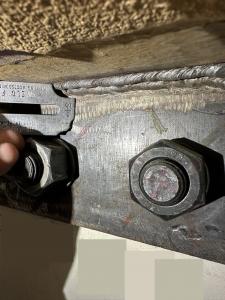Comprehending the Process of Welding Inspection Racine for Ideal Outcomes
Comprehending the Process of Welding Inspection Racine for Ideal Outcomes
Blog Article
Innovative Strategies to Fillet Weld Assessment and Screening: Enhancing Weld Quality and Compliance Criteria
In the world of welding, the high quality and integrity of fillet welds play a critical duty in guaranteeing the architectural sturdiness and reliability of various industrial parts. With the constant drive for enhanced efficiency and compliance with rigorous requirements, the expedition of ingenious strategies to fillet weld inspection and screening has ended up being essential. As sectors evolve, the traditional methods might no more be sufficient in meeting the demands of modern-day welding applications. By accepting sophisticated innovations and approaches, a brand-new horizon of possibilities emerges in the world of weld quality evaluation and adherence to conformity standards.
Advanced Non-Destructive Screening Methods
Utilizing cutting edge technologies, progressed non-destructive testing approaches play a critical duty in guaranteeing the stability and quality of fillet welds. These approaches, such as phased selection ultrasonic testing (PAUT) and magnetic particle testing (MPT), deal thorough insights into the weld's inner structure without creating any kind of damages to the product. PAUT, for instance, uses numerous ultrasonic aspects to examine the weld from different angles, offering a thorough visualization of possible defects like lack of blend or splits.
By using these sophisticated non-destructive screening strategies, weld examiners can accurately assess the top quality of fillet welds, ensuring compliance with industry criteria and guidelines. The ability to identify problems early on not just enhances weld high quality yet likewise stops expensive rework or failures in structural integrity, highlighting the relevance of these ingenious testing strategies in welding evaluations.
Robotics and Automation in Examination
The combination of robotics and automation has actually transformed the examination procedure for fillet welds, enhancing performance and precision in top quality analysis. Robotics supply precise control and repeatability in inspecting welds, making certain dependable and consistent results. Automated systems can be programmed to comply with particular inspection courses, making sure complete insurance coverage of welds and lowering the threat of human mistake.
Robotic inspection systems furnished with advanced sensors can discover and gauge weld attributes with high accuracy, providing in-depth information for evaluation. These systems can identify defects such as cracks, absence of combination, and porosity, allowing punctual restorative activities to be taken. Furthermore, robotics and automation enable real-time information collection and evaluation, providing prompt feedback to operators and helping with quick decision-making processes.
Additionally, making use of robotics and automation in fillet weld assessment enhances general productivity by minimizing examination times and increasing assessment throughput. By simplifying the examination procedure, suppliers can make certain weld high quality and conformity requirements are fulfilled efficiently, ultimately causing cost savings and improved item high quality.
Utilizing Expert System for Evaluation
Expert system plays a critical role in enhancing the performance and accuracy of evaluation in fillet weld evaluation processes. By using the power of AI, assessors can streamline the analysis of weld quality and compliance standards, leading to much more trusted and accurate results. AI formulas can swiftly refine vast amounts of data from weld inspections, spotting issues or disparities that may be testing to relate to the naked eye. This sophisticated modern technology allows real-time surveillance of weld top quality, enabling immediate corrective activities to be taken if any type of problems are discovered.
Furthermore, AI systems can find out from past assessment information, continuously boosting their ability to identify prospective flaws and discrepancies in fillet welds. This adaptive understanding capability improves the general quality assurance process, decreasing the likelihood of human mistake and making certain that welds fulfill the called for criteria. By incorporating artificial knowledge right into fillet weld evaluation, sectors can accomplish greater levels of performance, consistency, and compliance in their assessment practices.
Portable Tools for On-Site Assessment
 Enhancing area inspection performance, the fostering of mobile devices changes on-site evaluation procedures for fillet welds. These devices offer adaptability and ease, allowing examiners to carry out detailed assessments in numerous places, including tough or remote atmospheres. Mobile devices such as ultrasonic testing tools, magnetic particle evaluation devices, and digital radiography systems provide real-time data and high-resolution imaging abilities, enabling fast decision-making and prompt comments on weld quality.
Enhancing area inspection performance, the fostering of mobile devices changes on-site evaluation procedures for fillet welds. These devices offer adaptability and ease, allowing examiners to carry out detailed assessments in numerous places, including tough or remote atmospheres. Mobile devices such as ultrasonic testing tools, magnetic particle evaluation devices, and digital radiography systems provide real-time data and high-resolution imaging abilities, enabling fast decision-making and prompt comments on weld quality.One substantial benefit of portable tools is their capacity to streamline evaluation procedures, reducing downtime and improving general productivity. Assessors can conveniently transport these tools to various task websites, eliminating the requirement for transferring heavy equipment or components important source to off-site centers. Additionally, the transportability of these tools promotes cost-effectiveness by reducing transportation costs and increasing inspection timelines.
Additionally, using portable devices for on-site evaluation advertises positive quality assurance actions, as examiners can quickly identify and resolve any type of prospective welding defects or discrepancies. By including these cutting-edge modern technologies into on-site assessment methods, welding experts can make sure compliance with industry standards and enhance weld top quality, eventually bring about boosted architectural stability and security in various welding applications.
Combination of Data Monitoring Solution
Having enhanced on-site examination processes via the application of mobile tools, the next phase includes the smooth assimilation of information monitoring systems to further boost efficiency and information analysis capacities in fillet weld examination and screening. Welding Inspection Racine. By integrating information administration systems right into the examination process, companies can streamline information collection, storage space, and analysis. This combination enables for real-time surveillance of weld top quality, prompt recognition of flaws, and timely decision-making to rectify any kind of issues that may occur throughout the assessment procedure
The combination of data administration systems enables smooth communication between various stakeholders entailed in the assessment process, fostering collaboration and boosting total quality control steps. Eventually, the integration of data administration systems serves to boost the requirements of fillet weld evaluation and testing, ensuring conformity with market regulations and improving weld quality.
Conclusion
Finally, cutting-edge methods to fillet weld inspection and screening have significantly enhanced weld high quality and conformity criteria. Advanced non-destructive screening approaches, robotics, automation, expert system, portable devices, and information monitoring systems have transformed the means weld evaluations are carried out. By using these innovations, industries can make certain that welds fulfill additional hints the needed quality requirements and regulations, inevitably boosting total efficiency and safety and security in welding procedures.

By utilizing these advanced non-destructive screening strategies, weld assessors can accurately analyze the top quality of fillet welds, ensuring compliance with sector requirements and laws. Mobile tools such as ultrasonic screening devices, magnetic particle evaluation tools, and digital radiography systems offer real-time information and high-resolution imaging abilities, allowing fast decision-making and immediate feedback on weld top quality.
Having enhanced on-site assessment procedures with the utilization of mobile devices, the next stage involves the seamless combination of data administration systems to further enhance effectiveness and data evaluation abilities in fillet weld assessment and testing (Welding Inspection Racine). Inevitably, the combination of information monitoring systems offers to important link elevate the requirements of fillet weld examination and screening, guaranteeing compliance with market regulations and boosting weld top quality
 In conclusion, innovative techniques to fillet weld inspection and testing have actually considerably improved weld quality and compliance requirements.
In conclusion, innovative techniques to fillet weld inspection and testing have actually considerably improved weld quality and compliance requirements.Report this page